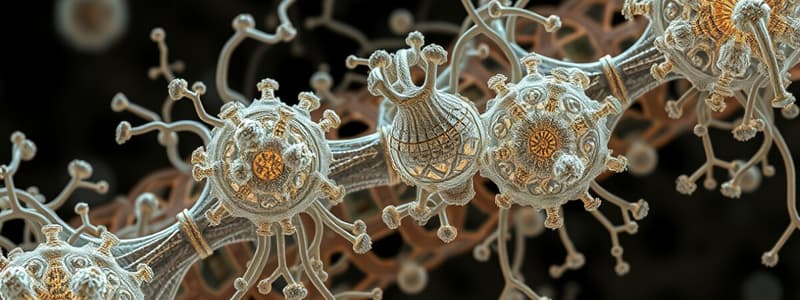Podcast
Questions and Answers
What are ribosomes composed of?
What are ribosomes composed of?
- RNA and protein (correct)
- Lipids and carbohydrates
- Only proteins
- DNA and proteins
What is the primary site of membrane assembly in the endomembrane system?
What is the primary site of membrane assembly in the endomembrane system?
Endoplasmic Reticulum (ER)
Smooth ER synthesizes lipids, breaks down toxins, and stores calcium ions.
Smooth ER synthesizes lipids, breaks down toxins, and stores calcium ions.
True (A)
What distinguishes rough ER from smooth ER?
What distinguishes rough ER from smooth ER?
Which type of cells do not contain a membrane-bound nucleus?
Which type of cells do not contain a membrane-bound nucleus?
Eukaryotic cells contain membrane-bound organelles.
Eukaryotic cells contain membrane-bound organelles.
Animal cells do not have __________.
Animal cells do not have __________.
What are the two main components of cell theory?
What are the two main components of cell theory?
What structure encloses the contents of a cell?
What structure encloses the contents of a cell?
What are organelles?
What are organelles?
What are microvilli primarily concerned with?
What are microvilli primarily concerned with?
What is the purpose of antibodies?
What is the purpose of antibodies?
Which microscope produces images of thin sections?
Which microscope produces images of thin sections?
Match the following structures with their definitions:
Match the following structures with their definitions:
What is the fluid component of the cytoplasm called?
What is the fluid component of the cytoplasm called?
What does the nucleus contain?
What does the nucleus contain?
What separates the nuclear contents from the surrounding cytoplasm?
What separates the nuclear contents from the surrounding cytoplasm?
Segments of DNA that serve as units of hereditary information are called __________.
Segments of DNA that serve as units of hereditary information are called __________.
What type of RNA is involved in protein synthesis?
What type of RNA is involved in protein synthesis?
What is chromatin?
What is chromatin?
What structures contain chromatin and genes?
What structures contain chromatin and genes?
What is the nucleolus responsible for?
What is the nucleolus responsible for?
Flashcards are hidden until you start studying
Study Notes
Ribosomes
- Composed of RNA and protein; can be found attached to the endoplasmic reticulum (ER) or free in the cytosol.
- Responsible for synthesizing polypeptides in both prokaryotic and eukaryotic cells.
Endoplasmic Reticulum (ER)
- A multifunctional network of folded membranes located in the cytosol.
- Acts as the primary site for assembling membrane components of the endomembrane system.
- Two main types: smooth ER (lipid synthesis and toxin breakdown) and rough ER (protein manufacturing).
Smooth ER
- Key functions include synthesizing lipids and breaking down toxins.
- Acts as a storage site for calcium ions.
Rough ER
- Dedicated to the manufacture of proteins, characterized by ribosomes studding its outer surface.
Prokaryotic Cells
- Features a nuclear area without a membrane-bound nucleus, typically housing DNA.
- Usually lack membrane-bound organelles and possess a cell wall and ribosomes; some may have flagella.
Eukaryotic Cells
- Distinguished by containing a membrane-bound nucleus and membrane-bound organelles.
Plant Cells
- Contain a nucleus, cell wall, large vacuole, and often chloroplasts.
- Typically do not have flagella (except in certain sperm cells) or centrioles.
Animal Cells
- Comprise a nucleus and centrioles.
- Lack cell walls, vacuoles, and chloroplasts.
Cell Theory
- States that cells are the basic living units of organization and function in all organisms and that all cells arise from pre-existing cells.
Plasma Membrane
- Encloses cell contents, regulating material movement in and out.
- Maintains cell shape and facilitates communication between cells; present in all cell types.
Organelles
- Internal structures within a cell that perform specific functions.
Microvilli
- Small projections of the plasma membrane that enhance the cell's surface area.
- Primarily found in absorption or secretion-related cells, such as those in the intestines or kidney tubules.
Light Microscope (LM)
- Utilizes light refracted by glass lenses to magnify images for observation.
Antibodies
- Specific proteins (immunoglobulins) prepared by plasma cells to recognize and bind to particular antigens.
Transmission Electron Microscope (TEM)
- Electron microscope designed for imaging thin sections of samples.
Scanning Electron Microscope (SEM)
- Electron microscope used to create detailed images of cell surfaces.
Cell Fractionation
- A method for isolating cellular components by applying centrifugal force.
Nuclear Area (Nucleoid)
- The region within a prokaryotic cell that houses the DNA, not enclosed by a membrane.
Cell Wall
- Extracellular structure that surrounds the entire cell, present in prokaryotic and plant cells.
Flagella
- Long, whip-like structures that provide locomotion by functioning as propellers on the cell surface.
Cytoplasm
- The portion of the cell located outside the nucleus.
Nucleoplasm
- The substance within the nucleus of the cell.
Cytosol
- The fluid component of the cytoplasm, responsible for nutrient transport and cellular processes.
Nucleus
- The most prominent organelle, containing the cell's genetic information coded in DNA.
Nuclear Envelope
- Comprises two membranes that separate nuclear contents from the cytoplasm, featuring nuclear pores for communication.
Genes
- Segments of DNA acting as units of hereditary information.
Messenger RNA (mRNA)
- Molecules synthesized in the nucleus by transcribing DNA, which then move to the cytoplasm where ribosomes manufacture proteins.
Chromatin
- The combination of DNA and protein that constitutes eukaryotic chromosomes.
Chromosome
- Structures within the nucleus containing chromatin and genes.
Nucleolus
- Specialized region within the nucleus composed of parts of several chromosomes, primarily involved in ribosome production.
Studying That Suits You
Use AI to generate personalized quizzes and flashcards to suit your learning preferences.




